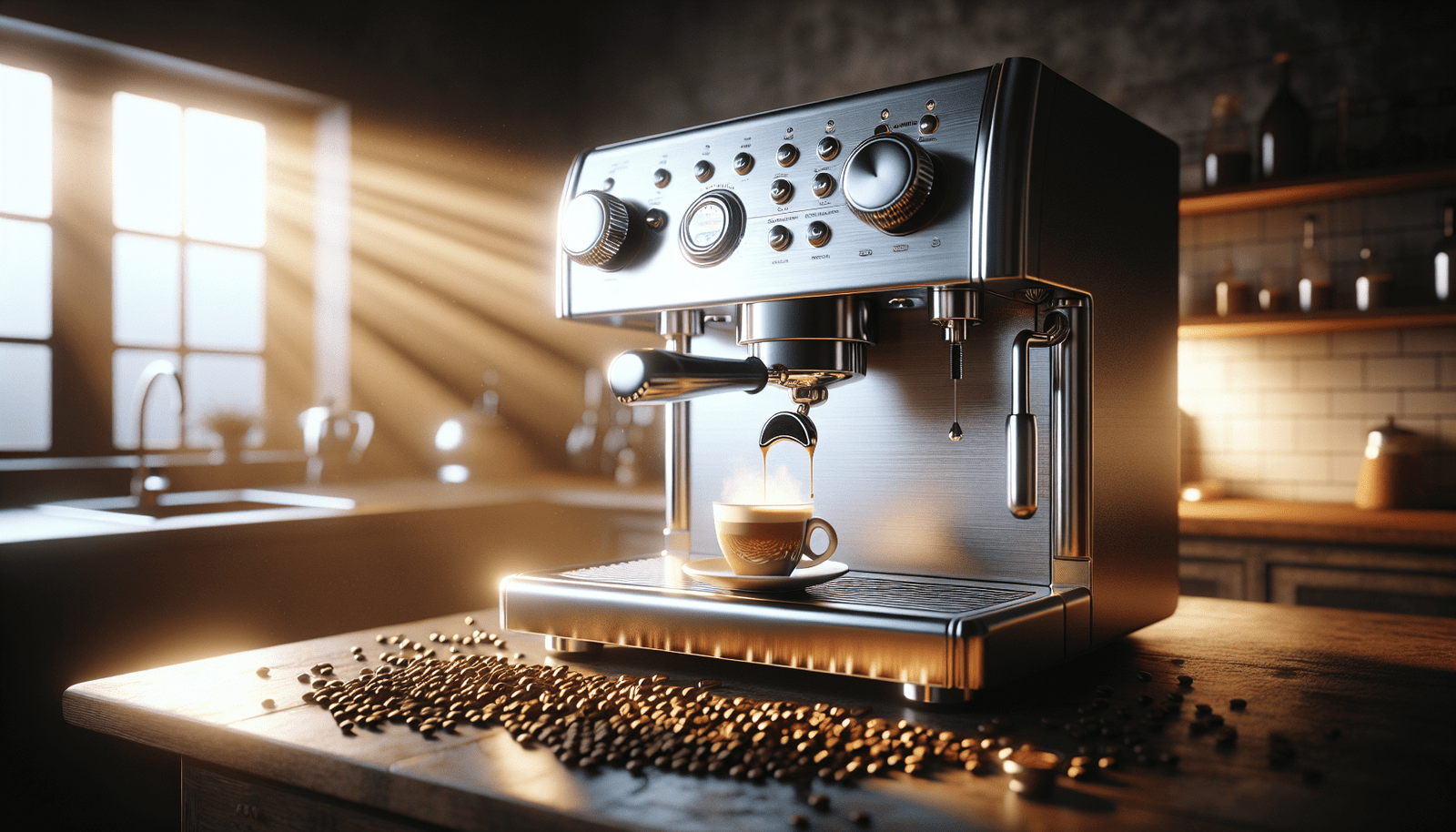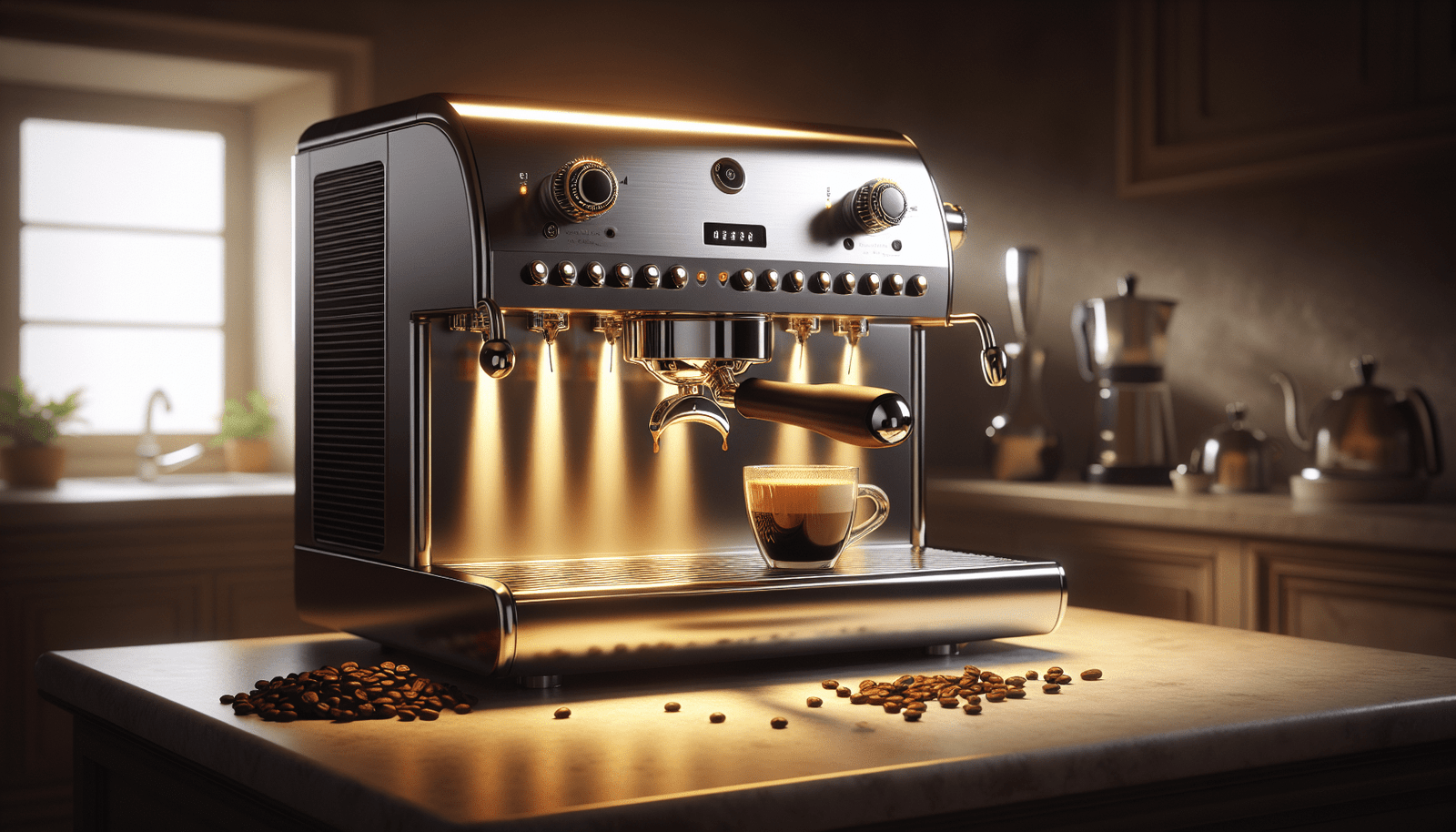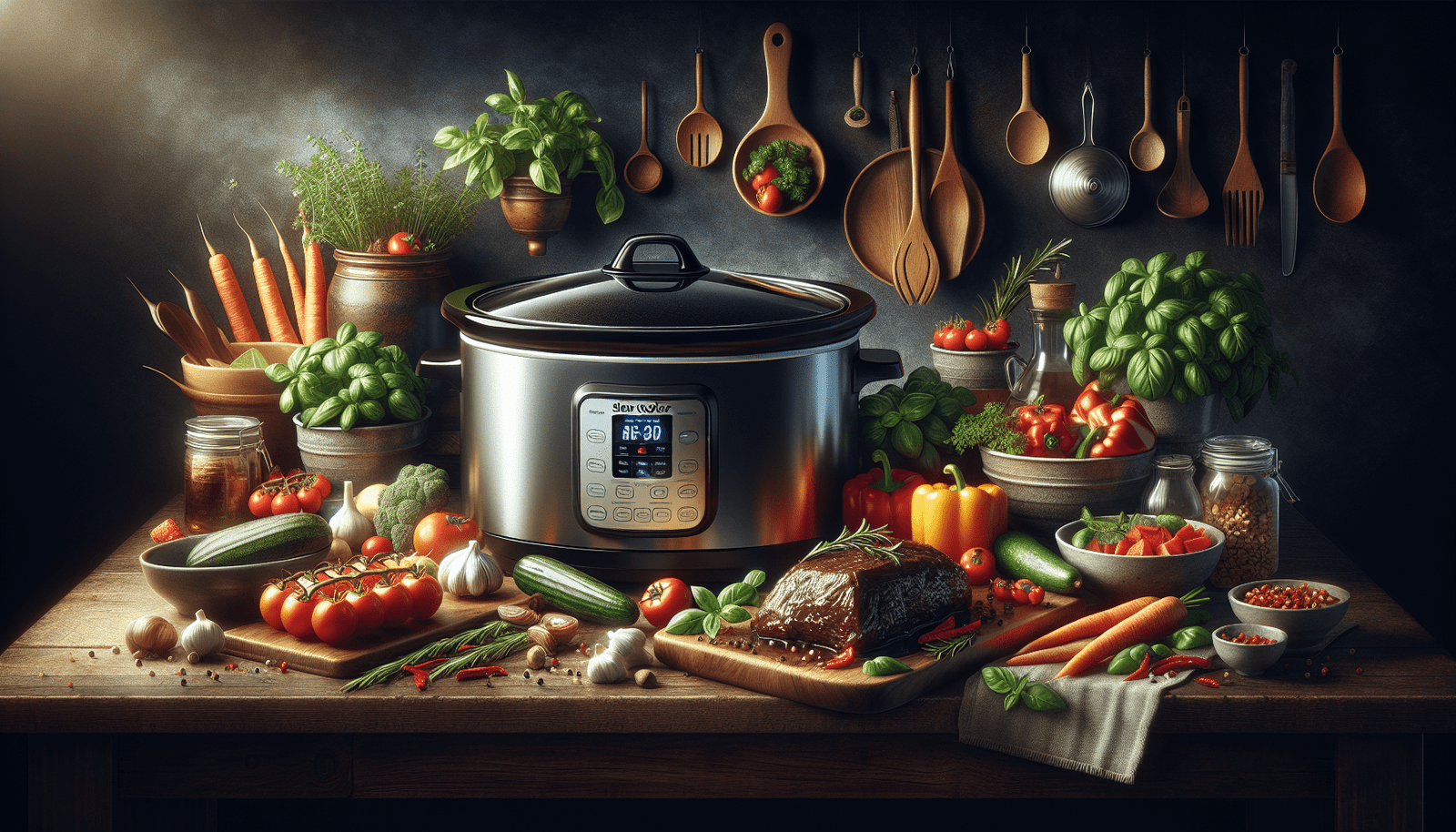Imagine stepping into the enchanting world of Cooking Appliance World, where each appliance is a stepping stone toward culinary mastery—none more so than the versatile espresso machine. With a promise to deliver only the finest in kitchen cooking appliances, gadgets, utensils, and supplies, envision yourself unlocking new realms of coffee potential right in your own kitchen. Espresso machines, the crown jewels among our selection, offer you the chance to indulge in barista-quality coffee from the comfort of your home or escalate the coffee experience in professional settings. Embark on a journey guided by expert reviews and exclusive deals to find your perfect coffee companion and transform your kitchen into a haven of efficiency and delight, where every sip of espresso is a testament to your culinary journey.

Understanding Espresso and Its Significance
The basics of espresso
Espresso is more than just a coffee beverage; it’s an art form that requires precision, skill, and the right equipment. When you press the button on your machine, hot water is forced through finely-ground coffee under high pressure. This process, typically requiring nine to fifteen bars of pressure, extracts the rich, concentrated flavors that define a great shot of espresso. The hallmark of a well-made espresso is its crema, a creamy, golden layer that floats on top, offering a smooth texture and aromatic first sip.
Historical evolution of espresso machines
The journey of espresso machines dates back to the late 19th century, marking an era of innovation in coffee brewing. Starting with Angelo Moriondo’s patent in 1884, coffee making underwent a transformation. Over the decades, machines evolved from bulky, steam-powered behemoths to the sleek, efficient models gracing kitchens and cafes today. It wasn’t until the mid-20th century when Achille Gaggia revolutionized espresso with the lever machine, introducing the high pressure necessary for crema, that espresso culture truly flourished.
Espresso vs. other coffee brewing methods
What sets espresso apart from other brewing methods is its distinctive extraction process. Unlike drip coffee, French press, or pour-over, which rely on longer brewing times and gravity, espresso is defined by its rapid extraction under high pressure. This results in a beverage that’s more concentrated, both in flavor and in caffeine per ounce. This intensity and depth of flavor make espresso the backbone of other popular drinks, like lattes, cappuccinos, and Americanos.
Types of Espresso Machines
Manual Espresso Machines
For the purists and traditionalists, manual espresso machines offer hands-on control over every aspect of the brewing process. Lever-press designs require you to manually generate the pressure needed for extraction. While challenging to master, they reward patience and practice with unparalleled precision and a sense of accomplishment.
Semi-Automatic Espresso Machines
Semi-automatic machines strike a balance between control and convenience. They automate the pressure, but leave grind size, tamping, and sometimes temperature control in your hands. This type is popular among enthusiasts who enjoy tailoring their espresso but appreciate the machine handling the heavy lifting.
Automatic Espresso Machines
Automatic espresso machines simplify the brewing process further, offering one-touch operation. They’re designed to maintain consistent pressure and temperature, removing variables that can affect your espresso quality. While they provide consistency, they offer less customization than their semi-automatic counterparts.
Super-Automatic Espresso Machines
For espresso at the touch of a button, super-automatic machines are the pinnacle of convenience. These marvels of modern engineering grind, tamp, brew, and even clean themselves. Ideal for those seeking high-quality espresso with minimal effort, they often come with customizable settings for personalized drinks.
Capsule Espresso Machines
Capsule machines represent the ultimate in convenience and consistency, using pre-packaged capsules to brew espresso. They eliminate the need to grind beans or tamper coffee, offering a quick, mess-free experience. While praised for their convenience, they offer less flexibility in terms of flavor profiling and strength adjustment.
Key Features to Look for in Espresso Machines
Pressure Pump Specifications
The heart of an espresso machine is its pressure pump, where 9 bars is the gold standard for extracting a rich, balanced shot. Higher bars might be boasted, but more important is the machine’s ability to sustain the optimal pressure throughout the extraction process.
Temperature Control Mechanisms
Temperature stability is crucial for espresso extraction. Look for machines featuring PID (Proportional-Integral-Derivative) controllers or dual boilers, as they provide precise temperature control, ensuring flavors are extracted consistently every time.
Built-In Grinders vs. Standalone Grinders
A built-in grinder adds convenience and saves space, offering a fresher grind before each brew. Standalone grinders, however, might offer more control over grind size and consistency. Your choice depends on your preference for convenience or control.
Milk Frothing Capabilities
If you’re a fan of lattes or cappuccinos, consider a machine with a powerful steam wand. Some high-end models even feature automated milk frothing and temperature control, delivering barista-quality milk texture right at home.
Water Storage and Filtration
A larger water reservoir means less frequent refills, an important consideration for heavy users or small offices. Integrated water filters can improve taste and protect the machine from scale buildup, extending its lifespan.
Ease of Maintenance and Cleaning
Ease of cleaning will influence your espresso experience. Removable drip trays, water tanks, and used coffee compartments make upkeep simpler. Look for machines that guide you through cleaning and descaling processes.
The Science of Espresso Extraction
Understanding Pressure and its Impact on Extraction
Pressure is what makes espresso, well, espresso. It forces water through the compacted coffee quickly, extracting a wide range of flavors in a short time. Too little pressure and your espresso could be weak; too much, and it might taste bitter.
The Role of Water Temperature
Optimal extraction occurs within a narrow temperature range, usually between 195°F and 205°F (90°C – 96°C). Temperatures outside this range can lead to under-extracted (sour) or over-extracted (bitter) coffee. Consistency is key to replicating your perfect shot each time.
Grind Size and Its Importance
The grind size for espresso is finer than for other brew methods, creating the resistance necessary for the water to extract flavors under pressure. Too coarse, and water rushes through, resulting in a weak shot; too fine, and the shot may be over-extracted and bitter.
The Tamping Process: Technique Matters
Tamping compresses the ground coffee into a puck within the portafilter, creating resistance to the water. Uniform pressure during tamping ensures even extraction, preventing channeling where water might find a less resistant path.

Improving Your Espresso Brewing Skills
Trial and Error: Perfecting Your Craft
Espresso brewing is both art and science. Don’t be discouraged by initial failures—they’re valuable learning experiences. Experiment with different variables, one at a time, to understand their effects on your final cup.
Training Resources and Tutorials
Numerous online resources, from blogs to video tutorials, offer invaluable insights. Dive into guides specific to your espresso machine model or general espresso-making techniques to expand your knowledge.
Joining Communities of Espresso Enthusiasts
Online forums and social media groups are great places to connect with fellow espresso aficionados. Share experiences, seek advice, and discuss everything from bean recommendations to troubleshooting.
Experimenting with Different Beans and Roasts
Espresso’s flavor is heavily influenced by the beans you choose. Experimenting with single-origin beans or blends, as well as various roast profiles, can introduce you to a spectrum of flavors and help you find your personal preference.
Selecting the Right Coffee Beans for Espresso
Understanding Coffee Bean Varieties
Arabica and Robusta are the two primary types of coffee beans, each with distinct flavor profiles. Arabica beans tend to be more acidic and have a wider range of flavors, while Robusta beans are stronger and more bitter. Your choice depends on your taste preference.
The Impact of Roasting on Flavor
Roasting transforms green coffee beans into the aromatic, flavorful beans we love. Light roasts are acidic and bright, while darker roasts are fuller-bodied with a bitterer taste. Medium roasts often strike a balance, making them popular for espresso.
Single-Origin vs. Blends for Espresso
Single-origin coffees offer unique, distinct flavors from their specific region. Blends, however, are designed to provide a balanced, consistent flavor. Trying both can help you appreciate the range of flavors espresso can offer.
Storage and Freshness
Freshly roasted beans are crucial for a flavorful shot of espresso. Once roasted, coffee beans should be used within a month for optimal freshness. Store them in an airtight container in a cool, dark place to preserve their quality.
Maintenance and Care for Espresso Machines
Regular Cleaning Regimen
Regular cleaning ensures your espresso machine functions optimally and extends its lifespan. This includes daily wiping down of the machine’s exterior, cleaning the drip tray, and flushing the group head.
Descaling Espresso Machines
Calcium deposits from water can clog your espresso machine over time. Descaling, or removing these deposits, is therefore crucial and should be done every few months, depending on water hardness and machine usage.
Replacing Worn Out Parts
Over time, parts like seals and gaskets may wear out and affect your machine’s performance. Replacing these as needed will help maintain the quality of your coffee and protect your machine.
Professional Maintenance Services
For high-end or commercial espresso machines, professional maintenance services can offer thorough cleaning and replacement of parts. This can be especially important for machines under heavy use or those with intricate mechanisms.
The Impact of Espresso Machines on Commercial Operations
Enhancing Efficiency in Coffee Service
Espresso machines significantly streamline the coffee brewing process in commercial settings, allowing for quick, consistent service. This efficiency can lead to higher customer satisfaction and increased sales.
Elevating Coffee Quality and Consistency
With precise control over brewing parameters, espresso machines ensure that every cup meets the high standards customers expect. This consistency in quality can help build a loyal customer base.
Training Staff for Optimal Use
Proper training is essential for maximizing the benefits of espresso machines in commercial settings. Staff should be knowledgeable about operation, maintenance, and basic troubleshooting to maintain service quality.
ROI Considerations for Businesses
While a quality espresso machine represents a significant investment, it can enhance the overall customer experience and drive sales. Businesses should consider their volume of coffee sales and desired quality level when selecting a machine.
Innovations and Trends in Espresso Machine Technology
Smart Espresso Machines
The advent of smart technology has reached espresso machines, offering features like programmable settings, remote operation, and maintenance alerts. These advancements can enhance both convenience and consistency.
Eco-Friendly Designs and Sustainability Consideration
Manufacturers are increasingly focusing on reducing the environmental impact of their machines. This includes energy-efficient models, recyclable capsules for capsule machines, and designs that minimize water usage.
Customization and Personalization Features
High-end machines now offer unprecedented levels of customization, from adjustable temperature and pressure settings to programmable drink recipes. Such features allow both enthusiasts and commercial users to tailor the brewing process to their exact preferences.
Emerging Brands and Models
The espresso machine market is constantly evolving, with new brands and models emerging to challenge established players. This competition drives innovation, offering consumers a wider range of options to suit their needs and budgets.
Choosing the Right Espresso Machine for Your Needs
Assessing Your Espresso Consumption and Preferences
Consider how much espresso you drink, what types of espresso-based beverages you enjoy, and how much time and effort you’re willing to invest in brewing. These factors will guide your choice of machine.
Comparing Price Points and Budget Considerations
Espresso machines range widely in price, from budget-friendly manual models to high-end super-automatic machines. Determine your budget early in the selection process but remember that higher initial costs can be offset by long-term durability and coffee quality.
Space and Design Aesthetics in Selection
Consider the size and design of the espresso machine in relation to your kitchen or business space. High-end models not only function as coffee makers but can also add to the aesthetic appeal of your space.
Warranty and Customer Support
A robust warranty and responsive customer support can safeguard your investment and provide peace of mind. Look for brands with a reputation for quality service and support.
In your quest for the perfect espresso, remember that the journey is as enjoyable as the destination. Experimenting with different machines, beans, and brewing techniques can unlock a world of flavors and experiences. Dive into the rich world of espresso and let your culinary creativity flourish.


